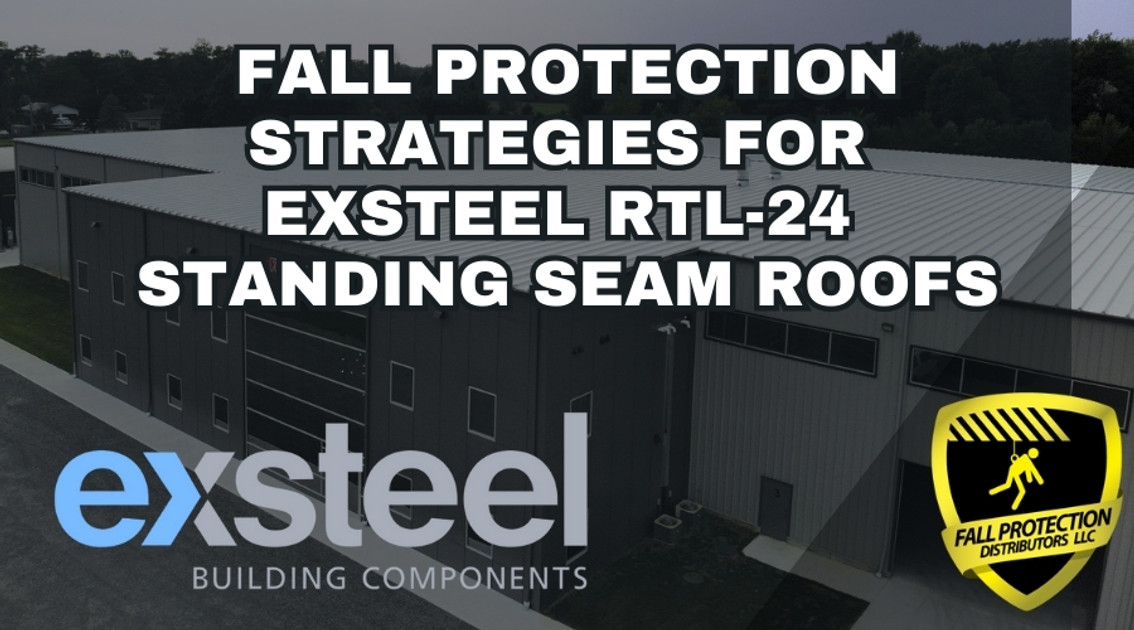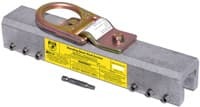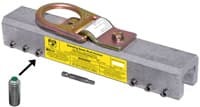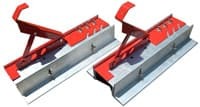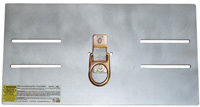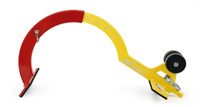Fall Protection Strategies For ExSteel RTL-24 Panels
Posted by Howie Scarboro - CEO Fall Protection Distributors, LLC on Aug 21st 2025
See the Roof Anchor Compatibility Chart for ExSteel Metal Roofing Supply Standing Seam Panels.

Who Is ExSteel?
ExSteel, based in Aylmer, Ontario, has established itself as a trusted name in the steel construction industry by producing high-quality roofing and wall systems that can withstand some of Canada's harshest weather conditions.
Their manufacturing facility serves as the hub for a full range of precision-engineered products, including the RTL-24 standing seam panel—a versatile choice for residential, commercial, and agricultural projects.
What sets ExSteel apart is its commitment to keeping production in-house and adhering to the strictest industry standards. ExSteel manufactures every product to meet ASTM A792 requirements, ensuring consistency and durability. Backing up that quality is a dedicated customer support team that provides technical guidance, detailed product data, and a promise of reliability.
Since opening their doors in 2004, ExSteel has supplied building components for new construction and retrofit projects across North America and beyond. Their work spans industries including industrial, agricultural, recreational, commercial, and institutional applications. The company's certifications—ISO 9001:2015, CSA A660, and CWB approval—underscore a system of accountability and quality assurance that customers can trust.
ExSteel's story began even earlier, as part of Steelway Building Systems, another member of the Ardent Industries family. Before 2004, Steelway manufactured steel components, including doors, windows, trims, and cladding, internally for its pre-engineered building projects. As demand grew, ExSteel formed to offer these high-quality components as standalone products to builders, contractors, and vendors across the region.
Today, ExSteel continues to deliver solutions that strike a balance between strength, functionality, and aesthetics. Their RTL-24 standing seam panels remain one of the most popular choices, offering flexibility for design, reliable performance in harsh environments, and the kind of craftsmanship that builders can confidently stand behind.
Why Are Compatible Fall Protection Anchors Critical For ExSteel Panels?
Standing seam roofs, such as ExSteel's RTL-24 panels, are designed for optimal performance and longevity.
The raised seams create a watertight barrier, keeping water out and maintaining the roof's strength year after year. That same seam design is also what makes them unique in terms of fall protection. Traditional screw-down anchors may seem like a quick solution, but driving fasteners through a standing seam panel defeats the very purpose of the system. Every penetration risks a leak, voids warranties, and weakens the integrity of the panel itself.
The solution is non-penetrating anchors that clamp directly to the seams. These anchors utilize specialized set screws to create a secure tie-off point, eliminating the need for drilling holes in the roof. By attaching to the seam instead of drilling through it, they protect both the worker and the investment in the roofing system. Contractors gain a reliable fall arrest connection, and building owners avoid costly water damage, rusting, and repair bills down the road.
It's also a matter of compliance. OSHA requires a 5,000-pound anchor point for fall arrest, and seam-mounted anchors provide that strength without compromising the roof's design. On ExSteel panels, selecting the right anchor ensures and preserves the company's precision engineering. At the same time, ensuring crews have the safety they need to get the job done.
In short, compatible fall protection anchors are not just an accessory—they are critical to protecting the workers on top of the roof and the roof system itself.
RTL-24 Trapezoidal Panels
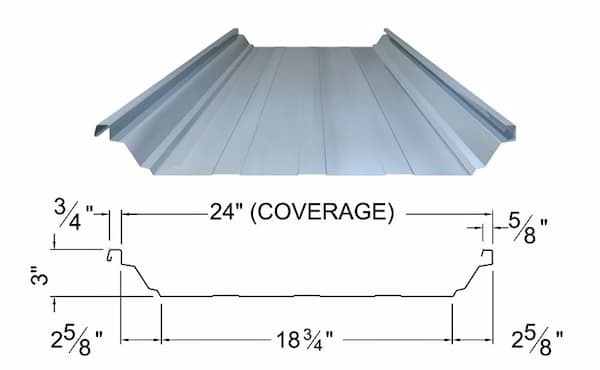
ExSteel's RTL-24 trapezoidal standing seam panel combines structural strength, weather resistance, and a modern aesthetic, making it suitable for a wide range of applications, from residential homes to large-scale commercial and agricultural buildings.
ExSteel manufactures each panel in 22- and 24-gauge steel, measuring 24 inches wide with a 3-inch seam height, and builds them to ASTM A792 standards with a 50 ksi yield strength. That foundation of durability is what gives the RTL-24 its reputation for long-term reliability under Canada's harshest conditions. See the Roof Anchor Compatibility Chart for ExSteel Metal Roofing Supply RTL-24 Trapezoidal Standing Seam Panels.
What makes the trapezoidal seam different is its ability to handle demanding loads without requiring a solid deck beneath. The large trapezoidal seams create rigidity across wider spans, reducing the amount of structural support needed while maintaining strength. This benefit makes the system more economical on large projects while still meeting the highest standards of safety and performance.
Weather tightness is another significant advantage. With seams that lock together in progressively stronger configurations—RollLoc for standard conditions, TripleLoc for more challenging environments, and QuadLoc for high-wind zones—the RTL-24 can be adapted to the specific demands of a project. These seams ensure that water stays out, even in driving rain or snow. At the same time, the concealed fasteners preserve the clean look of the roof and eliminate the risk of leaks associated with exposed screw systems.
Beyond its strength and performance, the RTL-24 boasts a sleek, architectural profile that enhances the visual appeal of buildings. The trapezoidal rib gives the roof a bold, dimensional look that stands out compared to flat or low-profile systems, making it a favorite among designers and builders seeking to blend aesthetics with functionality.
Perhaps most importantly for building owners, trapezoidal standing seam systems, such as the RTL-24, are known for their longevity. With a service life measured in decades—often 40 years or more—these panels require minimal maintenance and withstand repeated cycles of wind, rain, snow, and UV exposure without compromising their integrity. That combination of long life and low upkeep makes them one of the most cost-effective choices over the lifespan of a building.
Fall Protection For RTL-24 Trapezoidal Panels
The longevity of a standing seam roof depends on maintaining the system's watertightness and integrity, which makes non-penetrating anchors essential for worker safety.
ExSteel's RTL-24 panels are fully compatible with seam-mounted anchors and lifeline systems that clamp directly to the seam without drilling, thereby protecting both workers and the roof itself.
The SSRA1 Seam Anchor is the foundation of the system. Built from solid 6061-T6 aluminum, it clamps directly onto the raised seam with stainless steel or nylon-tipped set screws, depending on the panel gauge. Each anchor creates a 5,000-pound tie-off point that meets OSHA and ANSI fall arrest requirements. Contractors appreciate its lightweight design, which makes it easy to position anywhere along the seam, while building owners benefit from a completely non-penetrating attachment that doesn't risk leaks or void warranties.
Installing the SSRA1 establishes a secure foundation for additional tools that enhance safety and boost productivity. The SSRA2 Adjustable Roof Jack Adapters mount on top of the SSRA1 Anchors and provide a secure base for 10-foot wooden walk boards. This setup provides crews with a stable work platform across large sections of the roof, which is especially useful for solar installers, painters, or contractors who require both mobility and safety while working overhead.
For jobs requiring horizontal mobility, the SSRA3 Anchor Plates are applicable. These plates mount on top of the SSRA1 Anchors and serve as the attachment points for temporary lifeline systems. By connecting a rope between the SSRA3 Anchor Plate assemblies, workers can move across the roof while staying tied off the entire time. This ability makes them ideal for long spans or large roof areas where maximum worker mobility is necessary.
The 100-foot SSRA Horizontal Lifeline Kit provides four SSRA1 Anchors, two SSRA3 Anchor Plates, and a 100-foot lifeline, tensioner, and energy absorber—everything needed to set up a temporary OSHA-compliant horizontal lifeline. It's a turnkey solution that saves time on setup while ensuring crews have the protection required.
For facilities that require long-term or permanent tie-off points, the 120-foot Super Anchor Permanent Horizontal Lifeline Kit provides a reliable, built-in system. Once installed, it allows multiple workers to remain tied off while performing maintenance, inspections, or repairs. Its permanent nature means it's always ready when crews return, reducing setup time and increasing long-term safety.
Finally, the Ridge Pro Steep Assist offers an additional layer of versatility for steeper RTL-24 roofs or situations where seam clamping isn't suitable. This anchor hooks over the ridge of the roof and secures a vertical lifeline, giving workers safe access to pitches from 6/12 to 12/12 without damaging the panels. It's portable, lightweight, and a trusted solution for roofers, insurance inspectors, and contractors who frequently encounter steep slopes.
Together, these products form a complete safety ecosystem. The SSRA1 Anchors create the base, while the SSRA2 and SSRA3 expand functionality. The lifeline kits provide scalable solutions for both temporary and permanent setups. Paired with the Ridge Pro Steep Assist for steep-slope work, they ensure crews can work on ExSteel's RTL-24 panels with confidence, knowing both the roof system and their safety are fully protected.
Metal Roof Anchor Panel Compatibility For ExSteel
| RTL-24 Trapezoidal Panels 22-24 ga. |
|
|---|---|
| YES | |
| YES | |
| YES | |
| YES | |
| YES |
Contact Us For More Information
For further details on roofing solutions and fall protection systems, contact us at 863-703-4522 or www.StandingSeamRoofAnchor.com. Let's work together to make your roofing projects safe, beautiful, and built to last. For more safety tips, refer to OSHA's 48-page Fall Protection Manual. Once you have determined the most suitable anchors for your roof system, download our free Anchor Inspection Form.
Safety Tips For Standing Seam Roofs
Promote a Culture of Safety
Equipment and checklists matter, but culture is what truly protects people. A team that looks out for one another, raises concerns without hesitation, and starts every shift with a quick safety talk is statistically less likely to face accidents. When safety becomes habit instead of an afterthought, workers perform with confidence.
Ensure Proper Footwear for Stability
On a standing seam roof, safe footing is critical. Boots with deep tread, firm ankle support, and slip-resistant soles give workers the grip they need. Proper footwear not only prevents slips but also reduces fatigue, helping crews stay steady and alert.
Consult Experts for Curved Metal Panels
Curved panels can be tricky when it comes to providing tie-off anchors. Curved seams don't behave the same way as straight runs, which means not every anchor is appropriate. Before clipping in, it's advisable to have an experienced safety professional inspect the roof. Their expertise ensures that anchors, lifelines, and tie-off methods match the geometry of the roof system, thereby protecting both the panel and the personnel working on it.
Use Specialized Anchor Systems for Standing Seam Roofs
Standing seam panels stay watertight for decades, but they require specialized non-penetrating anchors. Driving a fastener through the seam can lead to leaks, rust, and warranty issues. Seam-mounted anchors clamp directly to the seams with no penetrations, preserving the roof's integrity and giving workers a 5,000-pound tie-off point they can trust.
Set Up Protective Guardrail Barriers for Work Zones
Guardrails are one of the simplest yet most effective safety measures on a roof. Once installed around edges, skylights, or hatches, they require no training and no adjustments. They provide both a visual cue and a physical barrier, turning fall hazards into secured work areas. For busy crews and crowded sites, that passive protection is hard to beat.
Develop OSHA-Compliant Safety Plans
Every safe project starts long before boots hit the roof. A written plan establishes expectations for fall protection, rescue protocols, and the role of each worker. It's not paperwork for the sake of paperwork—it's a roadmap for when conditions change or emergencies arise. A crew that knows the plan is better prepared to handle surprises without scrambling.
Install Permanent Roof Anchor Systems
Roofs that see regular foot traffic shouldn't rely on temporary setups. Permanent anchors create ready-to-use tie-off points every time someone climbs up. That reliability saves workers setup time and gives owners confidence that safety is always in place, whether it's for maintenance crews, solar installers, or inspectors.
Encourage the Use of Trauma Straps
Arresting the fall is just the first step, but what happens after matters too. Hanging motionless in a harness can quickly cut off circulation, leading to suspension trauma. Trauma straps provide relief by allowing a suspended worker to stand in their harness, thereby restoring blood flow while rescue crews mobilize. For such a simple accessory, they're one of the most innovative life-saving tools available.
Equip Workers with High-Quality Safety Gear
Even the best anchors won't help if the gear is in bad condition or ill-fitting. A properly adjusted harness, dependable lanyards, and self-retracting lifelines that meet OSHA and ANSI standards give workers confidence in their tie-off. Daily inspections should be standard practice, ensuring that every piece of gear on site is ready to handle a real fall event. In 2025, OSHA clarified that employers must provide workers with properly fitting harnesses and other safety equipment.
Prioritize Ladder Safety Training
Not every accident starts on the roof—many occur while accessing it. Ladders account for a large share of fall injuries, which is why training is essential. Teaching the 4-to-1 placement rule, stressing three points of contact, and securing tie-offs drastically reduce risks. Quick, hands-on refreshers keep crews sharp, especially when job site access points change frequently.
Disclaimer
The views, recommendations, and information presented in this blog are solely those of the author and do not necessarily reflect the opinions or positions of the featured panel manufacturer, its brands, subsidiaries, or parent companies. Customers are strongly encouraged to contact the roof panel manufacturer directly for inquiries regarding fall protection compatibility with their products and to address any potential warranty issues that may arise after installing our products.

